#rocky planet composition
Text
Where to Settle on Mars
The story behind “Red Gold” needed the settlers to make a totally unexpected discovery, so I used my imagination. I eventually got an agent, the book went to an editor of a major publisher, but the editor died and the replacement cleared his desk, and apparently informed the agent that my story was “too far-fetched”. So, what was far-fetched? Colonization of Mars? Someone trying out a fraud to…
View On WordPress
#elements in rocky planets#Hellas Planitia#Martian rivers#origin of ores#original Martian atmosphere#rocky planet composition#salts
0 notes
Text

Let's Explore a Metal-Rich Asteroid 🤘
Between Mars and Jupiter, there lies a unique, metal-rich asteroid named Psyche. Psyche’s special because it looks like it is part or all of the metallic interior of a planetesimal—an early planetary building block of our solar system. For the first time, we have the chance to visit a planetary core and possibly learn more about the turbulent history that created terrestrial planets.
Here are six things to know about the mission that’s a journey into the past: Psyche.

1. Psyche could help us learn more about the origins of our solar system.
After studying data from Earth-based radar and optical telescopes, scientists believe that Psyche collided with other large bodies in space and lost its outer rocky shell. This leads scientists to think that Psyche could have a metal-rich interior, which is a building block of a rocky planet. Since we can’t pierce the core of rocky planets like Mercury, Venus, Mars, and our home planet, Earth, Psyche offers us a window into how other planets are formed.

2. Psyche might be different than other objects in the solar system.
Rocks on Mars, Mercury, Venus, and Earth contain iron oxides. From afar, Psyche doesn’t seem to feature these chemical compounds, so it might have a different history of formation than other planets.
If the Psyche asteroid is leftover material from a planetary formation, scientists are excited to learn about the similarities and differences from other rocky planets. The asteroid might instead prove to be a never-before-seen solar system object. Either way, we’re prepared for the possibility of the unexpected!

3. Three science instruments and a gravity science investigation will be aboard the spacecraft.
The three instruments aboard will be a magnetometer, a gamma-ray and neutron spectrometer, and a multispectral imager. Here’s what each of them will do:
Magnetometer: Detect evidence of a magnetic field, which will tell us whether the asteroid formed from a planetary body
Gamma-ray and neutron spectrometer: Help us figure out what chemical elements Psyche is made of, and how it was formed
Multispectral imager: Gather and share information about the topography and mineral composition of Psyche
The gravity science investigation will allow scientists to determine the asteroid’s rotation, mass, and gravity field and to gain insight into the interior by analyzing the radio waves it communicates with. Then, scientists can measure how Psyche affects the spacecraft’s orbit.

4. The Psyche spacecraft will use a super-efficient propulsion system.
Psyche’s solar electric propulsion system harnesses energy from large solar arrays that convert sunlight into electricity, creating thrust. For the first time ever, we will be using Hall-effect thrusters in deep space.
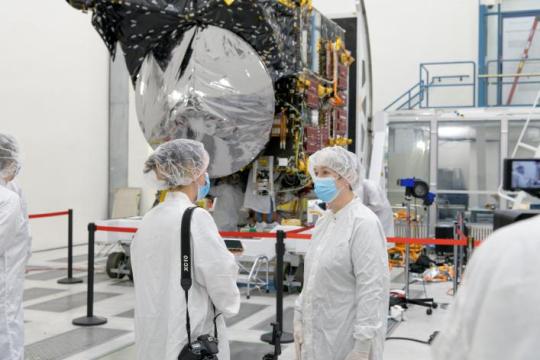
5. This mission runs on collaboration.
To make this mission happen, we work together with universities, and industry and NASA to draw in resources and expertise.
NASA’s Jet Propulsion Laboratory manages the mission and is responsible for system engineering, integration, and mission operations, while NASA’s Kennedy Space Center’s Launch Services Program manages launch operations and procured the SpaceX Falcon Heavy rocket.
Working with Arizona State University (ASU) offers opportunities for students to train as future instrument or mission leads. Mission leader and Principal Investigator Lindy Elkins-Tanton is also based at ASU.
Finally, Maxar Technologies is a key commercial participant and delivered the main body of the spacecraft, as well as most of its engineering hardware systems.
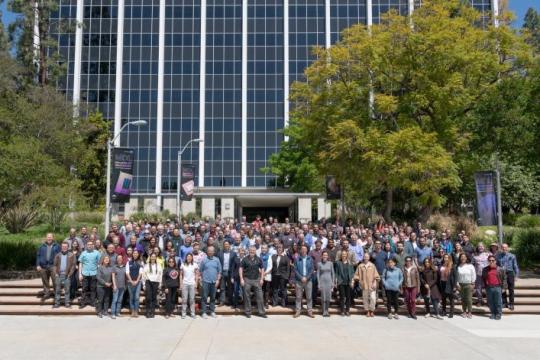
6. You can be a part of the journey.
Everyone can find activities to get involved on the mission’s webpage. There's an annual internship to interpret the mission, capstone courses for undergraduate projects, and age-appropriate lessons, craft projects, and videos.
You can join us for a virtual launch experience, and, of course, you can watch the launch with us on Oct. 12, 2023, at 10:16 a.m. EDT!
For official news on the mission, follow us on social media and check out NASA’s and ASU’s Psyche websites.
Make sure to follow us on Tumblr for your regular dose of space!
#Psyche#Mission to Psyche#asteroid#NASA#exploration#technology#tech#spaceblr#solar system#space#not exactly#metalcore#but close?
2K notes
·
View notes
Text
So I wanna tell y'all about something very near and dear to my heart.

This is the Psyche asteroid, or, at least an artist's representation - we don't know what it actually looks like yet, but this is a fair enough guess. It's a roughly 200 mile wide asteroid in the asteroid belt, and it's made almost entirely out of metal. Its composition makes it unique; it’s the only large metallic body we know of in the entire solar system.
We think it might be the core of what used to be a planet.
When solar systems form, they start out as disks made of interstellar gas and dust, called protoplanetary disks. Here's a picture of HL Tauri, one of the best images of a protoplanetary disk we have.
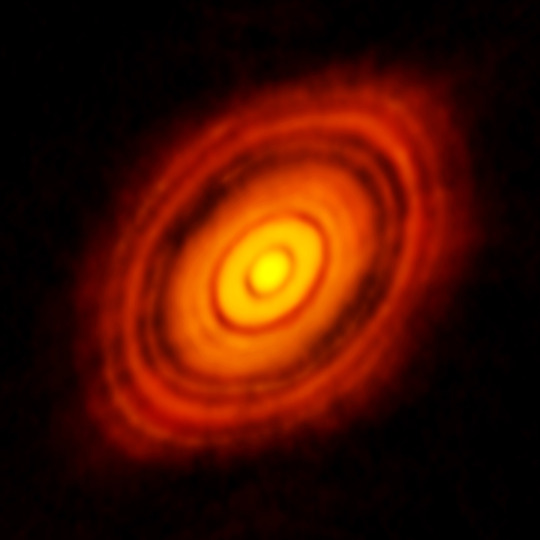
That dust globs together into larger and larger pieces, and eventually forms hundreds of "planetesimals", which are rocky bodies about a kilometer across. Planetesimals had very erratic orbits compared to the modern planets - the dust of the protoplanetary disk caused friction and drag, which threw them off course.
They frequently collided with each other, and either broke apart or stuck together and grew even larger. Arrokoth is actually a leftover planetesimal, a time capsule from the early solar system, and we were able to visit it wayyy out in the Kuiper belt with the New Horizons probe!
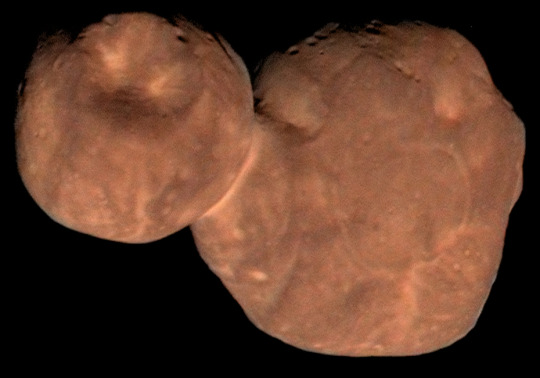
Once planetesimals get to be about the size of the moon, we call them "protoplanets". Protoplanets were fundamentally different from their planetesimal siblings - we believe they were differentiated. When an object in space gets big enough, a combination of radioactive decay, impacts, and gravitational pressure causes them to heat up and melt. Denser materials like iron and nickel sink towards their centers, while the lighter materials rise to the surface. The differentiation process is why Earth's core is made of iron, while the surface is primarily rock.
While protoplanet orbits were much more stable than those of planetesimals, they still eventually collided with each other until everything settled into the planets we see today (though gas giants had a few extra steps - that's a different post!).
We think the Psyche asteroid was a protoplanet, well on its way to becoming a bona fide planet, when an impact struck it hard enough to strip away its rocky layers, leaving behind the dense, metallic core - like in this illustration.
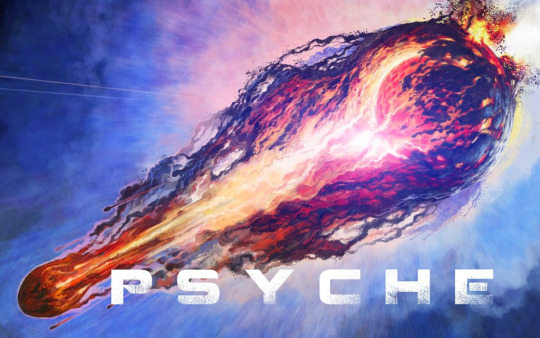
More and more, we think the properties of a planet's core are fundamental to its long-term evolution. Venus, Earth, and Mars are all roughly the same size and roughly the same distance from the sun, cosmically speaking, yet they're so different! Venus has hell death clouds, Earth is home, and Mars is dry and dead - why?
The Psyche asteroid gives us the unique opportunity to actually observe a planetary core directly - it's much harder to dig to the center of a planet than it is to go to space, so that's exactly what we're going to do!
On Thursday October 12th at 10:16am Eastern, the Psyche spacecraft will launch and begin its journey to the asteroid belt! You can watch at https://www.nasa.gov/nasatv/!

I've been a part of this mission for over four years now, and I can't speak highly enough of the team that made it happen through all of the ups and downs. Good luck out there, buddy. We're all rooting for you :')
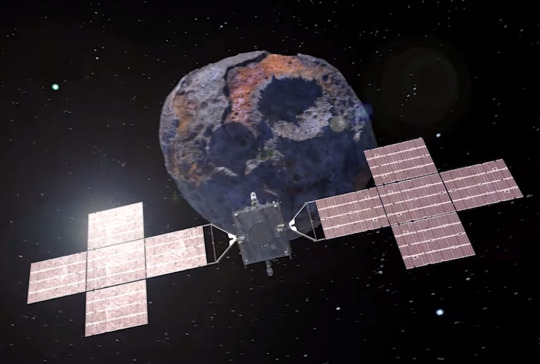
#space#NASA#psyche#asteroid#planet#psyche mission#long post#get home safe friend#you're gonna see some amazing things#For real y'all this mission has been my every single day for the past four years#I grew up with this project#end of an era but beginning of something new!#spost
378 notes
·
View notes
Photo

2024 May 17
Aurora Banks Peninsula
Image Credit & Copyright: Kavan Chay
Explanation: This well-composed composite panoramic view looks due south from Banks Peninsula near Christchurch on New Zealand's South Island. The base of a tower-like rocky sea stack is awash in the foreground, with stars of the Southern Cross at the top of the frame and planet Earth's south celestial pole near center. Still, captured on May 11, vibrant aurora australis dominate the starry southern sea and skyscape. The shimmering southern lights were part of extensive auroral displays that entertained skywatchers in northern and southern hemispheres around planet Earth, caused by intense geomagnetic storms. The extreme spaceweather was triggered by the impact of coronal mass ejections launched from powerful solar active region AR 3664.
∞ Source: apod.nasa.gov/apod/ap240517.html
105 notes
·
View notes
Text
2024 May 17

Aurora Banks Peninsula
Image Credit & Copyright: Kavan Chay
Explanation: This well-composed composite panoramic view looks due south from Banks Peninsula near Christchurch on New Zealand's South Island. The base of a tower-like rocky sea stack is awash in the foreground, with stars of the Southern Cross at the top of the frame and planet Earth's south celestial pole near center. Still, captured on May 11, vibrant aurora australis dominate the starry southern sea and skyscape. The shimmering southern lights were part of extensive auroral displays that entertained skywatchers in northern and southern hemispheres around planet Earth, caused by intense geomagnetic storms. The extreme spaceweather was triggered by the impact of coronal mass ejections launched from powerful solar active region AR 3664.
Authors & editors: Robert Nemiroff (MTU) & Jerry Bonnell (UMCP)
30 notes
·
View notes
Text
A Speculative Analysis About Irkens No One Asked For: Part I

Dem green fellas. Them lil guys, they’re an interesting pack of critters, aren’t they?
I used to really fixate on them back in middle and high school, stronger than everyone else seemed to be on the spazz in the dog costume. Jhonen Vasquez’s worldbuilding has always towed a very fine line between nonsensically ridiculous and surprisingly logistical, and this balance is typified in everything we know, and can infer, about these bug-eyed imperialists at the center of everything Invader Zim. So, let’s infer, and take a crack at it since no one’s stopping us anyway- More specifically, some thoughts and ponderings I had about how they “tick” as a fully realized society, not just a sci-fi monster..
A Homeworld Obscured
Now, to really understand the history and “deal” of any civilization, or any animal, usually you would turn to their environment first to give you some handy clues and context.
Small problem, though: We actually don’t get much in the way of direct, explicit showing or explanations about Irk itself when it comes to the show. This makes some sense, given that the whole of what they do worth showing (and the most notable members of their kind) exists almost entirely off-world. So instead, we mostly find out more about Irk from what Invader Zim does tell us about its natives. As far as confirmed canon goes, we know that Irk’s atmosphere appears red, its surface is entirely and densely urbanized, and it’s long been depicted in starmaps with a set of Saturn-like rings.

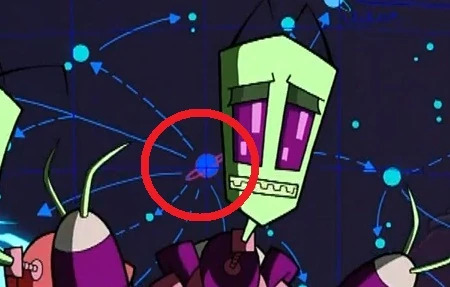
This last fact is probably the most interesting, because planetary rings are usually something we, in our own little solar system, would only associate with massive, gaseous worlds, not terrestrial ones. What These rings are made of is really anyone’s guess- could be ancient debris from natural satellites, Water-ice particles, maybe even some form of artificial defense network put into orbit by the Irkens themselves. If they aren’t artificially created, this would suggest that Irk has quite a strong gravitational field- greater than that of any of our neighborhood’s rocky planets. This is the common theory I personally like to subscribe to, because it would also go hand and hand with explaining why the average height of the irken race is so much shorter compared to that of an adult human. It fits neatly into the “why” question for the sort of athletic skill and agility we’ve seen invaders able to demonstrate on Earth, too, for otherwise being of meek physical prowess. It even adds some credible context for why the very achievement of growing to a more substaintial height is both uncommon and associated with extreme survival fitness to them.
A Fun fact that’s about to be relevant: “Rayleigh scattering” is the term given to when light wavelengths become shifted and scattered through an atmosphere medium. Long story short, it’s the reason our sky has color to it during the day. Stay with me on this.
I’ve also seen some people take a go at the red-looking surface, guessing a different gas makeup than the elements on earth responsible for our blue skies. I’m gonna go against the grain here, and actually contest that. I think that Irk’s atmosphere is coincidentally extremely similar to Earth’s. We know well enough that they both have a similar composition of gases breathable to both societies, given that Zim, Skoodge, and Tak all seemed pretty comfortable without some form of assistance on the same dirtball as humanity. Instead, I propose that Irk’s magenta skies are actually the symptom of heavy pollution. Sunsets and sunrises in the real world are known to make the sky appear more reddish-orange, even pink, as is. Usually, Rayleigh scattering has the light From the sun appear bluish in full midday, but during low sun, the rays are coming at an angle making them have to travel farther before reaching us, so you have already stretched light waves getting the same treatment from the air and, well, a higher frequency blue turns down to the lower end of the spectrum, red and yellows.
And wouldn’t you know, air pollution can actually do the same thing. THIS is why there's a scary ass orange haze known to accompany the presence of massive forest fires and volcanic eruptions. Earth’s most polluted cities even experience longer and redder sunsets for the same reason.


Left: Image of a lilac sky over a Chinese city experiencing heavy smog levels
Right: Intense red haze spotted over towns in Indonesia in the wake of rampant rainforest fires
On Earth, Zim stared directly into the midday sun without hesitation, nor concern that it would literally blind him. I think the planet hue and this is plenty enough to guess the likely case that Irk’s surface probably doesn’t get a lot of direct sun on an average day as is, and the sheer amount of unbroken cityscape that covers the homeworld would be the more obvious suspect than just having a more distant star from them. If they overcrowded to the point of their expansion, why build their civilization deeper into the ground, instead of up? Maybe there's actually a good reason or two they don’t raise their young topside.
A Psychology Molded for Domination
As well, I want to chirp about real world space again for a second. So, anyone up to the buzz in geek circles and aware of the math on the matter probably got the memo: humanity is almost matter-of-fact certainly not alone in this sandbox of a universe (or at the very least, we won’t always be alone). Like, about as certainly as we were about Black holes’ existence before we up and observed the real thing. And while it’s probably not going to happen in any of our lifetimes, sci-fi and media generally have been trying to take a crack for years at what the theoretical first contact with an alien civilization is going to look like.

And I’m gonna go ahead and say it,
As “cliche” and Hollywood as the conquering little green/grey dudes trope might have become… it’s actually not a wild take after all. The little and green thing, that’s creative liberty, but the part about them being hostile and something we may not actually even WANT to be aware of our existence? That’s an idea that even the smarty pants experts have been fearing the realistic odds of, even including the late Stephen Hawking .
The Evolution of intelligent life is a hard thing to really pin down and predict, given that we literally only have the one example to study. Under the right conditions, what reason would another advanced species NOT have to be equally as expanding, as exploitative of its resources, self-destructively short-sighted, and as supremacist as humans have already demonstrated themselves to be capable of? There is a lot of very interesting literature that suggests BOTH empathy/altruism and or aggression/tribalism to be (at least in the short term) very rewarding characteristics for an intelligent social species to develop.
And that’s the thing about the behavior of the Irken Armada I think has always been fascinating. Their drive to be the biggest definitionally invasive species across the cosmos is framed exactly as irrational, bumbling, and pointless as it deserves to be; however, is it not just the extended conclusion of every empire that has existed here on Earth, if only it had survived long enough to achieve the technology of Irk? And yet, it’s reminiscent, like the rest of their design, to the far from sapient, yet very real world creatures they appear to be most inspired by: hive and colony building arthropods. Whether the next point I'm about to touch on should be seen as a rejection of that resemblance, or further elaboration of it is anyone's to answer.
Transhumanism, or.. Transirkenism, in this case?
Like the specifics of what Irk really looks like and how it realistically works, a bunch about the aliens’ physical biology is left to scattered tidbits to ponder and piece together into a bigger picture. A few of those tidbits are as follows, drip-fed to us over the course of aired and scripted but never released episodes:
+ From the mouth of Vasquez himself, it has been confirmed that Irkens lack any form of reproductive organs. Instead, they rely on industrialized facilities to grow and produce them in a factory sense.
+ Yet curiously, they still demonstrate something akin to sexual dimorphism, or at least the cultural existence of masculine/feminine genders, where females are aesthetically set apart by the presence of curled antennae, eyelashes, and higher voices.
+ Irken lifespans are able to stretch far past that of an average human’s (Zim himself is cited to be around 2 centuries old in earth years).
+ Invader class soldiers have been implanted with surgical upgrades to their eyes.
+ Every Irken is fitted with a PAK that serves a wide array of utility and life-sustaining functions for its owner. These units are physically and neurologically connected into an Irken’s spine from “birth” and contain a cybernetic backup of an individual’s personality, assigned occupational programming, and memories.
That’s not close to a complete list by any means, but it’s got the gist of what I want to dwell on most, starting with the last bit; because the PAK isn’t done true justice in one statement. It is not an extra addition the way a prosthetic enhancement is, and it is not a tool the way armor and weapons are. It is literally analogous to a vital organ to these aliens, and they are shown to die within 10 minutes of being forcefully detached from their own.
The degree to which Irken bodies and minds rely on this technology, and how seamlessly they are integrated into it, ALONG with their completely artificial life cycle all directly points to the fact that their civilization has advanced into a cyborg-like stage of evolution. It may even be on track to reach a post-organical peak in due time, phasing out more and more of their “vestigial” and feeble meatsuits until they’ve become a true drone army. And that actually begs some huge questions now that we realize we will never know how much of the Irken anatomy was ever originally a natural feature. An Irken’s own brain practically comes secondary to the superior efficiency of the supercomputer on their back, capable of literally holding their own essence and being in the form of code. A code that can preserve the “self” even in the event of meatbody failure, being uploaded post-mortem into the Control Brains’ collective data and repurposed for a future generation of workers. It absolutely would stand to reason that the species has continued this biological self-tampering to other heights- extending their lifespans, incorporating untold amount of mechanical upgrades into their bodies, and maybe even genetically engineering their smeets to be so compatible with this technology.
The control brains themselves are a mesmerizing reflection of this change over time- the result of an evident shift long ago from technology serving them, to them serving the directives of computers. When you really pay attention to the control brains’ role in the series, it comes clear to you who (or what) is really in charge of their society. The Tallest still maintain their symbolic/cultural importance to the Irkens, but outside of their part in spearheading the active intergalactic invasion, they ultimately are figureheads when it comes to actually running the homeworld and ruling the lives of Irk’s inhabitants. If I had to bet money, I would say the Brains may even have the ability to choose and predetermine the next Tallest when a replacement is needed. But what does that make the Tallest? A meaningless title and transformation, chosen arbitrarily by the AI overlords? Well, I don’t think so, actually… but maybe that, and more on the “meaty” morphology of their race is all a tangent fit for another day and post ;)
#invader zim#irkens#long post#sci fi#iz fandom#scarlet talks about things#oh boy here i go hyperfixating again
146 notes
·
View notes
Text

ASU scientists help resolve 'missing methane' problem of giant exoplanet
In the quest to understand the enigmatic nature of a warm gas-giant exoplanet, Arizona State University researchers have played a pivotal role in uncovering its secrets.
WASP-107b has puzzled astronomers for some time, but recent findings, aided by NASA's James Webb Space Telescope and the Hubble Space Telescope, have shed new light on its unusual characteristics.
A remarkable revelation in the exploration of WASP-107b is the unforeseen scarcity of methane, or CH4, in its atmosphere. This intriguing discovery, hinting at a significantly hotter interior and a more massive core than previously hypothesized, has been a focal point of the research conducted by Luis Welbanks, a NASA Sagan Postdoctoral Fellow at the School of Earth and Space Exploration at ASU and lead author on a paper published today in Nature.
The high temperature is believed to be a consequence of tidal heating induced by the planet's slightly noncircular orbit.
“Based on its radius, mass, age and assumed internal temperature, we thought WASP-107b had a very small, rocky core surrounded by a huge mass of hydrogen and helium,” Welbanks said. “But it was hard to understand how such a small core could sweep up so much gas and then stop short of growing fully into a Jupiter-mass planet.”
Welbanks and the team's analysis, in conjunction with data from the Hubble Space Telescope, has led to a deeper understanding of WASP-107b's composition and dynamics. Contrary to earlier assumptions, the planet's inflated atmosphere does not result from extreme formation scenarios but rather from internal heat and tidal forces.
WASP-107b, a Neptune-like exoplanet discovered in 2017, has been identified as a pivotal subject for the study of low-density exoplanets. Its unique characteristics, offering valuable insights into planetary evolution and atmospheric dynamics, have been unraveled through advanced spectroscopic techniques by the researchers. The wealth of information about the molecules present in WASP-107b's atmosphere, including the simultaneous detection of carbon-, oxygen-, nitrogen- and sulfur-bearing molecules for the first time in a transiting exoplanet, further underscores its scientific value.
"The Webb data tells us that planets like WASP-107b didn't have to form in some odd way with a super small core and a huge gassy envelope," said Mike Line, associate professor in the School of Earth and Space Exploration at ASU. "Instead, we can take something more like Neptune, with a lot of rock and not as much gas, just dial up the temperature, and poof it up to look the way it does."
Overall, the groundbreaking research on WASP-107b underscores the importance of collaborative efforts in advancing our understanding of exoplanets. The research team's contribution, in conjunction with the support of NASA's James Webb Space Telescope and the Hubble Space Telescope, has been instrumental in this endeavor.
11 notes
·
View notes
Text
The Messenger space probe that was destined for Mercury launched in August 2004 and took 7 years to get into Mercury’s orbit. 7 years before it could finally, truly start its work.
Messenger was slingshot from inner planet to inner planet. Going from Earth to Venus, then back to Venus again, before completing three flybys of Mercury, only catching glimpses of its final destination. Until, finally, after 6 years, 7 months and 16 days, it slowed down enough thanks to those planetary flybys to safely enter orbit.
It travelled 7,9 billion km to get to Mercury, a planet that, at its closest, is only 77 million km away from Earth (you can't take a direct route because the sun's gravity will speed up the spacecraft too much).
Messenger then spent the next four years around that planet, from 2011 to 2015. And then, after those 4 years, after all the propellant was used up and it could no longer correct its orbit, it crashed down to the planet’s thin rocky surface. The one it had spent all those years observing.
All that time and distance travelled, only to spend 4 years around Mercury. 1505 days.
And it was all worth it.
Thanks to Messenger, we know so much about Mercury, the tiny crater-riddled planet at the heart of our solar system.
We know that in its polar regions, there is ice located in shadowy craters that the sunlight can never touch. We learned that, due to its cooling core, Mercury has contracted about 7 km in radius. We’ve learnt about its composition, its magnetic field, its past volcanic activity, and so much more.
Messenger went through 2 mission extensions, traveled about 14 billion km in total, took over 290,000 images, and mapped the whole of the planet for the first time.
We have thousands of detailed images of a planet so hard to get to, humanity is unlikely to see with its own eyes in my lifetime. And those images are all so beautiful.
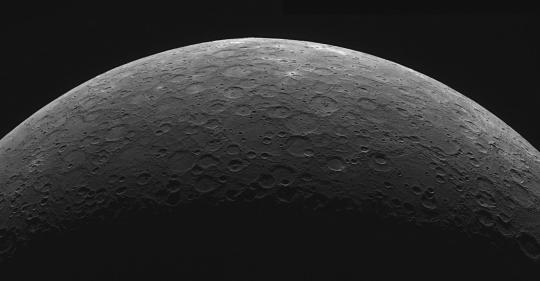
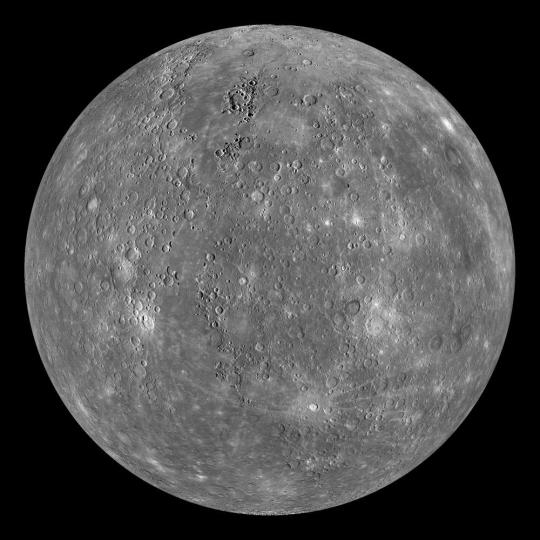

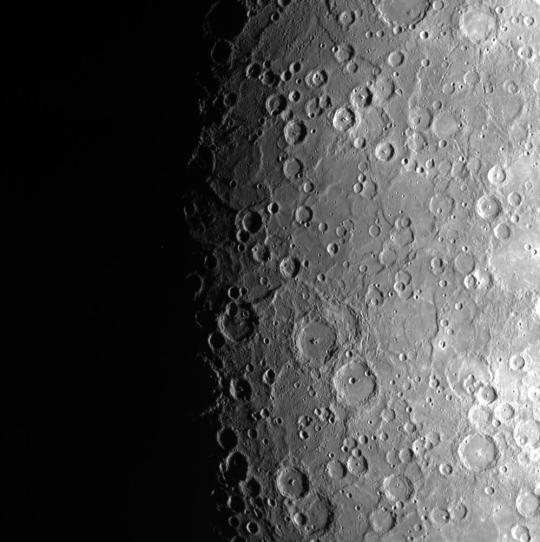
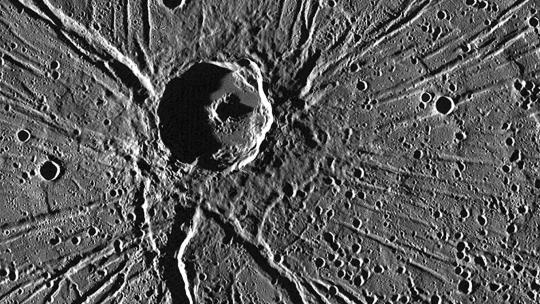
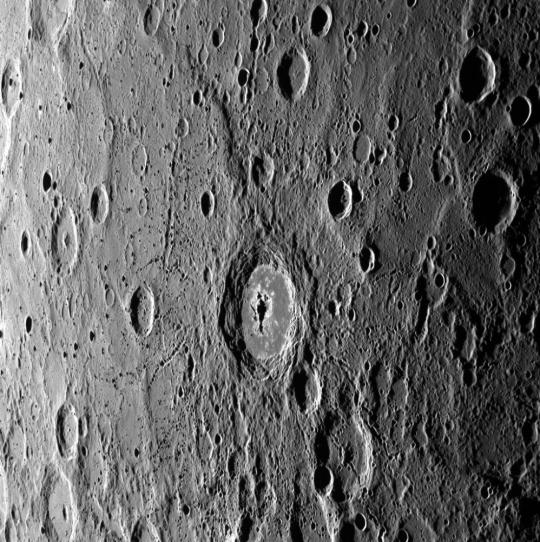


(all images are credited to: NASA/Johns Hopkins University Applied Physics Laboratory/Carnegie Institution of Washington)
[ID: 8 images of the planet Mercury taken from various angles at various distances]
#Messenger#Mercury#Sapce#Astronomy#Nature#Science#NASA#nasa photos#Don't mind me as I get emotional over a space probe that died 8 years ago#I feel prefectly normal over the Messenger space probe#Post#Mine#My post
19 notes
·
View notes
Note
Hello, would you mind doing a Rihanna/ASAP rocky synastry or composite analysis? Are there any celeb readings you're currently working on?

I have shipped them since the Fashion Killa music video lol
I couldn't find time of birth for Rocky, but we will work with what we have. I am pleasantly surprised to be honest. I have done her Synastry with Drake a few years ago and that was something.
I will begin by mentioning the best things I see in this synastry. The first of which is the Mars-Venus and Mars-Moon conjunctions. His Mars is conjunct her Venus and Moon. This indicates extremely strong chemistry, attraction, passion. The Mars-Venus is very romantic and shows two people who are very tuned in with each other's energy. The Mars-Moon conjunction is the classic intimacy aspect, it can point to a couple who are likely to have a child together. It shows that he is very, very protective of her. This is all in her 12th house, which can point to a very private, secretive relationship. His Mars also conjuncts her Juno so in a long-term relationship or marriage between the two he will be the one to lead. His Mars aspects definitely show that he is the one to pursue her.
His Mercury is in her 7th house so communication is good and they can be very considerate of each other. He can be the one to convince her, to influence her. His Moon is in her 4th house so there is a strong emotional bond. This is a good placement for starting a family, living together, as it can show two people who are tuned in with each other's feelings, nurture each other, protect each other.
His Venus is in her 5th house which is once again a very romantic placement. The 5th house is the house of joy, passion, sex, love, romance and Venus is the planet of love and romance, what more can you ask for? It can be indicative of a dramatic relationship though. They will probably do more creative projects together. His Juno is also in her 5th House which can show a very happy and fulfilling long-term relationship or marriage. His Jupiter is in her 2nd so they build each other up, they make each other feel confident.
Now the not so good. His Sun is in her 6th so they can view each other as a form of responsibility. They can be critical of each other, but want the best for the other person at the same time. His Juno and Venus are conjunct her Lilith so he probably put in a lot of effort to make her commit to him or want something more serious with him.
His Mars in her 12th house isn't ideal (His is making great aspects to her chart which does make it slightly better), but it can indicate that frustration is hidden, it can show the buildup of anger, secret drama, hiding things from each other. Her Mars is conjunct his Uranus and Saturn (she has the same aspects natally) so there can be slight chaos. Looking at this I am not surprised how they committed to each other very suddenly. There is also a Mars-Neptune conjunction which once again points to doing more creative projects together. His Neptune is in her 10th/conjunct her Midheaven so he can be a great source of inspiration for her.
His Mars is square her Mars, Saturn, Uranus and Neptune. So any fights or misunderstanding between the two can be very serious, very chaotic, very unclear. She is probably the stubborn one in the relationship and he is the one trying to fix things when something goes wrong. But there can be impulsivity in the relationship, living out fantasies.
His Neptune is square her Moon and Venus so he idolizes her and puts her on a pedestal. He is definitely infatuated by her, but there can be lack of boundaries in the relationship and he could be manipulative, especially emotionally. His Jupiter is square her Sun so his ego can definitely feel hurt by her. There can be a battle for attention in a way.
Overall, I think there is strong chemistry and long-term potential. I haven't read much about them, but they are both attractive and have had a friendship for a while which is always great.
#rihanna#asap rocky#astrology#synastry#zodiac signs#aries#taurus#gemini#celebrity astrology#cancer#leo#virgo#libra#scorpio#sagittarius#capricorn#aquarius#pisces
192 notes
·
View notes
Text
this is only like a 40% serious idea, but if i were going to reform scientific vocabulary around solar system bodies (and comparable bodies orbiting other stars), i would want:
a word for anything that orbits another thing that’s not a star, regardless of size or composition (i.e., a moon)
a general subcategory for anything large enough to be rounded by gravity (”ball”), vs anything too small for that (”-let”) (regardless of what it orbits or its composition)
a general subcategory for anything with an atmosphere that doesn’t dominate its composition (”air-”)
a word for bodies dominated by a massive gaseous envelope, with sub-categories for ones more like jupiter and saturn, and ones more like neptune and uranus (”[gas] giant” or “[ice] giant”)
a word for bodies that are predominantly rocky (mercury, the moon; atmospheric subcategory includes earth, venus, mars)
a word for bodies that are predominantly icy (enceladus, europa, pluto; atmospheric subcategory includes titan)
then we could talk about airmoons and icemoons and air-ice balls, and ice giant and gas giant balls, and rock balls and rocklets and icelets, and it would all sound a bit silly, but we wouldn’t have to argue about what is or isn’t a planet, and that word can just be “the things people visit in Star Wars.”
#plus then we could say things like 'the sun has four big balls and lots of little ones'#and that would be very funny
112 notes
·
View notes
Text

Welcome to Spero
Exoplanet Ahuizotl 593-d is about 15 light-years from Earth, located in the habitable zone of a yellow dwarf star much like our own. It is a rocky world, with an axial tilt of 7.2 degrees and a diameter of just over 12,000 km. It has a single large moon, somewhat smaller than earth's and very different in origin and composition; this moon is a recently-captured long-period comet, composed mostly of water ice beneath a dark protective layer of organic dust. Ahuizotl 593-d was renamed to Spero (meaning "hope") when it was chosen as a candidate for terraforming and colonization.
Prior to human arrival, Spero was a dead world. Though once tectonically active, it ceased to be so long before humanity arrived, and countless aeons of erosion have ground down the mountain ranges and filled in the ocean basins with sediment. Where once tall mountains stood proudly, small, wind-blasted rocks are all that remain; and where once vast oceans surged, endless fields of sand dunes stand still and lifeless. The only true topography that may be found is the rims of innumerable impact craters, slowly being worn away by the ravages of wind and sand. The largest of these is over 1,000 km across, and is relatively young, at a mere 80 million years old; It has not had time to erode away as completely as some of the other craters, and its eastern rim contains mountains that are much higher than anywhere else on the planet - nearly 3,000 meters high.
The oceans are not completely gone - they are buried, to be certain, but the water still exists deep beneath the sediment. In certain places, scattered across the globe, ancient seawater seeps to the surface, forming saltwater oases - in the depths of the largest crater, these springs seep into the basin to form a permanent lake. However, by far the largest body of water is the Mare Vagus, the so-called "wandering sea": a shallow, hypersaline body of water which travels around Spero's lowlands, propelled by the forces of erosion and deposition. On the windward coast, soft rock and sediment are slowly carved away, only to be re-deposited as sand or silt on the leeward coast; harder rock resists erosion, and may deflect the Mare's trajectory against the wind to the north or south. in this way the seas move across the planet, leaving behind them a trail of salt crystal evaporites that can be seen from space. These bodies of water fuel a small but consistent water cycle - a few freshwater rivers snaking down from the highlands are fed by rainfall.
Despite the bleakness of the landscape, the planet is habitable. The air is breathable, the rivers drinkable, the soil nontoxic, and the sun is almost identical to our own. In a universe where habitable planets are exceedingly rare, Spero is a veritable oasis, and within ten years of the planet's discovery humanity was already putting together a plan for colonization. However, the sheer distance from earth to Spero makes for an imposing barrier; the fastest starships in the human fleet (at 1/6th the speed of light) would have to travel for 95 years to reach it. It would be two hundred and fifty years between the arrival of the first probes and the arrival of humanity on the planet's surface. And humanity did not arrive alone. They brought with them their crops, their livestock - everything needed to prepare a planet for permanent human habitation.
Transporting plants and animals across interstellar space is not an easy feat. Due to the 95-year time gap between launch and arrival, everything living must be either put in cryogenic stasis or maintain a breeding stock on the spaceship for the duration of the flight. Since storage space is a limited resource on ships and carrying that many moving animals, plants, and people (not to mention food and water and life support systems) would be unimaginably expensive, cryostasis was by far the preferred option. For most plants and some animals, this made transport downright easy; simply keep the desiccated seeds or cysts into a low-temperature freezer and thaw them out upon arrival. Thousands of seeds could be transported this way while barely taking up any space at all. Hundreds of species from over 450 different families were brought to Ahuizotl.
Animals, on the other hand, needed a little more consideration. Cryogenic stasis is a complicated affair (though much simpler than transporting moving, breathing animals for 95 years) and requires some specialized equipment. Multiple tanks of liquid nitrogen were needed for every individual animal, plus the metabolic suppressors and the actual stasis chamber itself. For an average-sized human this resulted in a set of equipment which weighed some six hundred pounds and took up almost 2.5 cubic meters of cabin space. For a fully grown cow or camel, the requirements were even more ludicrous.
Fortunately, these huge apparatuses could be shrunken, if the animals themselves were also shrunken. If transported as embryos, with development completed in artificial wombs upon arrival to the planet, each individual animal only took up one-eighth of a cubic meter of space. This was much more reasonable, and so many more individuals could be transported, enough to preserve genetic diversity for multiple species. Even so, space was at a premium, and only 18 species of animal were introduced (three of which could undergo cryptobiosis and were simply chucked in the freezer with the seeds).
Colonization occurred in several waves; the first wave included bacteria, algae, and certain lichens and fungi, and began the process of terraforming by beginning soil production and establishing the foundation of the artificial ecosystem the colonists hoped to create. The second wave included more complex plants, including mosses and ferns, and the first animals - tardigrades, rotifers, and other small creatures which would recycle nutrients. Once these organisms were established and thriving (as determined by robotic probes), the third wave - including the first hardy crop plants, larger invertebrates, and the first fish - arrived. Finally, in the fourth wave, humanity arrived (accompanied by the remaining seed species) to be greeted by a thriving, if taxonomically limited, ecosystem.
~o~O~o~
Seed List
All species introduced to Ahuizotl underwent genetic manipulation and hybridization to increase hardiness and heterozygosity, maximizing chances of successful establishment and survival into the future. Species were chosen based on hardiness, adaptability, and – most importantly – usefulness to humans. The vast majority of plant species introduced were crops, producing food, timber, or other important products such as rubber and medicines. Animals were either livestock, herding animals, or detritivores necessary for healthy soils and nutrient cycling. Pest species were strictly avoided. Thanks to the extended time spent in cryogenic stasis (as well as close inspection and quarantining by scientists prior to freezing), diseases and parasites were almost completely eliminated.
(Plants not included in this list; there are too many to count. If it's reasonably hardy and useful to humans, it's safe to assume it was brought along.)

Domestic Goat ~ Capra hircus
Cattle were rejected for colonization due to their size and feed requirements - the productive pastures needed to raise them effectively simple didn't exist. Goats were introduced instead, as they could survive better on the sparse scrubby vegetation which had been established by that point. Goats were introduced for their milk, meat, and leather, and for their ability to survive in harsh environments.

Domestic Sheep ~ Ovis aries
Sheep were introduced for meat, milk, and (most importantly) wool. The sheep arriving on Ahuizotl were hybrids between several different wool-producing breeds, mostly of the fine-wooled merino type. Though unable to survive without human care due to the need for periodic shearing, the breeds chosen were very hardy and could survive in harsh climates.
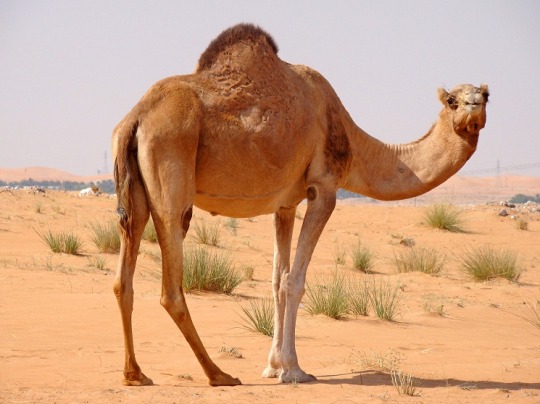
Dromedary Camel ~ Camelus dromedarius
Camels were introduced as pack animals and long-distance transport to desert outposts. They were also used for milk production. Camels were chosen based on their hardiness, pre-adapted to the desert climate of Spero as they were; able to survive on very little food or water and carry heavy loads for long distances, they would be invaluable, especially since Spero had no oil or petroleum deposits to produce fuel for motorized vehicles.
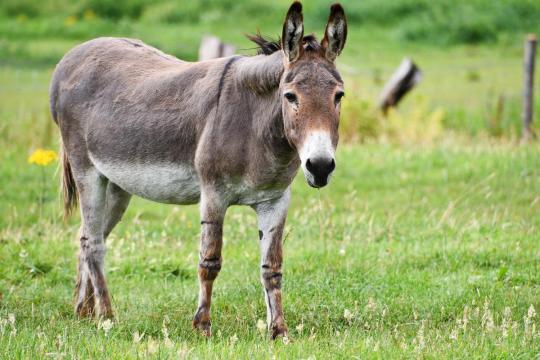
Domestic Donkey ~ Equus africanus asinus
Horses were considered for colonization as a means of transportation on a world where fuel was a highly limited resource, but were ultimately rejected in favour of donkeys. Donkeys were smaller than horses, but much hardier and required fewer resources. Donkeys were also used extensively for plowing and transportation in pulling carts - they were also significantly easier to handle and more comfortable to ride than camels.

Domestic Dog ~ Canis familiaris
Dogs were introduced as herding animals for goats and sheep, much more efficient than robotic substitutes. They had the added bonus of providing companionship to the human settlers (on a planet with a total population of less than 500 spread out over a vast area, loneliness was an ever-present problem). The dogs brought to Spero were all mutts with strong herding dog histories; border collies, blue heelers, and Alsatians were all prominently featured in the pedigrees.

Domestic Pig ~ Sus domesticus
Pigs were introduced mostly for their meat, but also for leather, manure, and disposal of organic wastes. They were also introduced for their unique ability to provide organs and tissues useful in medical applications, such as their heart valves. Hardy animals, able to survive on garbage, pigs were well adapted for surviving the turbulent early years of colonization.

Domestic Chicken ~ Gallus domesticus
Chickens were introduced for their meat and eggs, and their feathers were also used as a natural fiber for stuffing cushions and other necessary textiles. The chickens introduced were hybrid mixtures most similar to Indian and Polynesian breeds, but also included genes from western breeds such as leghorns, orpingtons, and wyandottes.

Common Carp ~ Cyprinus carpio
Fish was a critical nutrient source for the developing world, rich in Omega-3 fatty acids that could not be efficiently produced by plants. Although humanity makes use of many kinds of fish, most species require more advanced ecological environments to thrive. Carp, on the other hand, don’t; and while not typically considered food fish by western cultures their meat is tasty and nutritious. It is their ability to thrive in low-quality environments which made them better choices for colonization than more popular fish.

Flathead Mullet ~ Mugil cephalus
Mullets were introduced for many of the same reasons as carp. Adaptable, hardy, and able to survive in a wide range of temperatures and salinities, their diet of algae and bacterial scum allowed them to thrive in Ahuizotl’s estuaries. Unlike carp they congregate in large schools and so can be harvested in large quantities, an invaluable attribute once large numbers of colonists began arriving and expecting to be fed. The mullet introduced to Spero were genetically modified to have a flexible life cycle and a broader tolerance of salinity; they do not need to return to saltwater to breed, though they can still survive there just fine.

European Honeybee ~ Apis mellifera mellifera
On earth, bees are of critical importance, pollinating a huge proportion of the crops we rely on to produce our food. Thus, bees were practically guaranteed to be included in the seed list. Not only do they pollinate flowers, but the honey, wax, and other products produced by beehives are valuable commodities. The bees introduced are exclusively from the Western subspecies (A. m. mellifera); this is to prevent aggressive and swarming behaviours exhibited by hybrid bees on earth.

Common Woodlouse ~ Armidillidium vulgare
Woodlice were introduced as detritivores, aiding decomposition of excess organic matter and helping to keep soils fertile. This particular species was chosen based on its adaptability and hardiness compared to other woodlouse species, as they can tolerate drier conditions.
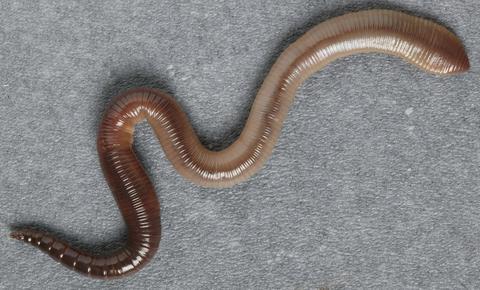
Common Earthworm ~ Lumbricus terrestris
Earthworms were introduced to aerate the soil and help keep croplands healthy. They also help to remove organic detritus such as fallen leaves and help mix soils, bringing nutrients within reach of plant roots. This species was chosen due to its ability to survive in diverse habitats.
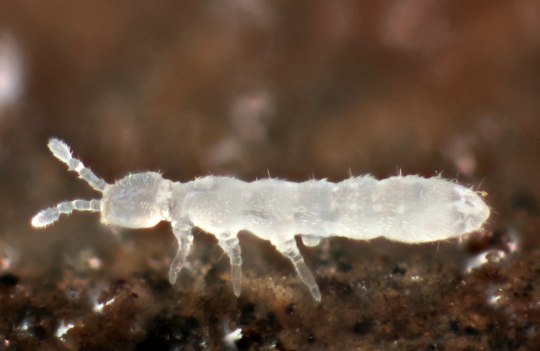
White Rat Springtail ~ Folsomia candida
Springtails were chosen as detritivores, recycling organic matter and keeping the soils fertile and healthy. They also serve as extra food for woodlice and earthworms. This particular species was chosen due to the ease of culture and adaptability.

Cherry Shrimp ~ Neocaridina davidi
Freshwater shrimp were introduced to help control the growth of bacterial and algal mats in riverine environments, keeping waterways clear. They also serve as a secondary food source for carp. This species was chosen due to its ease of culture.
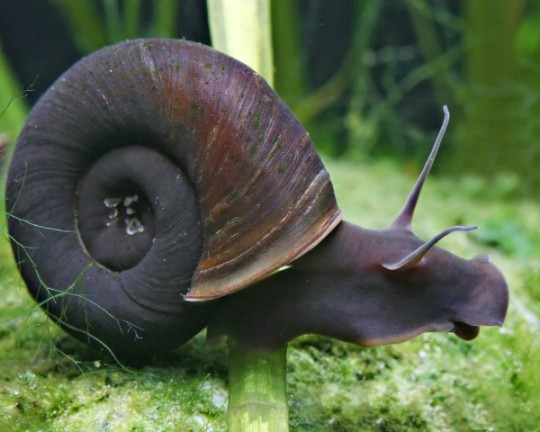
Ramshorn Snail ~ Planorbarius corneus
Like the cherry shrimp, freshwater snails were chosen to help keep down algal growth and keep waterways and rice paddies healthy and productive. They, like the shrimp, also serve as a secondary food source for carp.

Brine Shrimp ~ Artemia franciscana
Brine shrimp hold little value to humans, except as a food source for mullet, carp, and other marine species. They were mainly included because, as eggs, they can survive being frozen for long periods of time and so did not require the heavy cryogenic stasis equipment needed for most other animals. During early colonization they were used as a feed for the recently-thawed fish fry, and continued to be eaten by subsequent generations of larval fish.
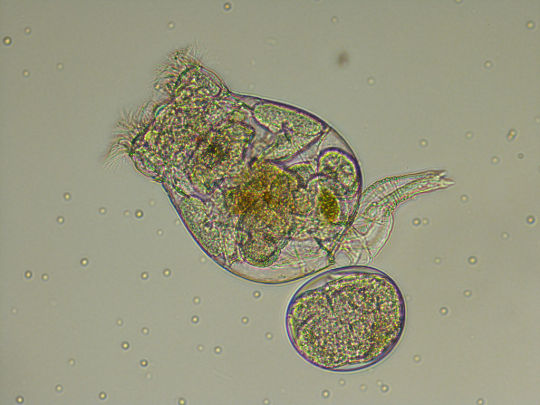
Rotifer ~ Brachionus plicatilis
Like the brine shrimp, the rotifers were included as larval fish food and because they could be transported easily and in large numbers with nothing more than a simple freezer. They were one of the first animals introduced to Ahuizotl, along with tardigrades, and were intended to form the base of a self-sufficient aquatic ecology.
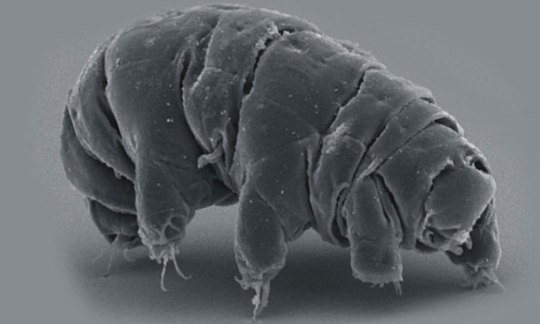
Tardigrade ~ Milnesium tardigradum
Tardigrades were chosen as pioneer animals to help create usable soils. They also provide food for larger invertebrates such as snails, isopods, and springtails. Thanks to their ability to withstand low temperatures for long periods of time in a cryptobiotic state, they could be brought in large numbers in a simple freezer.
~o~O~o~
These eighteen species of animals - and hundreds of species of plants - were cultivated to form a self-sufficient ecosystem in the dusty, dry wastes of Spero. Croplands, orchards, and timber plantations were planted along the banks of the rivers; farther from water, scrubby grasses and hardy forage plants grew in the infrequent rainfall. While the vast majority of the planet was still hostile desert, endless sand dunes or bare rock swept clean by the wind, humanity managed to eke out an existence along the narrow inhabitable margins of the rivers.
Until a cataclysmic event destroyed humanity's hope of creating a new home... and simultaneously laid the groundwork for Spero to become a thriving paradise far beyond their wildest dreams.
#speculative biology#spec bio#speculative evolution#spec evo#map#seed world#Vicis Aeternum#Spero#fantasy map#personal project
45 notes
·
View notes
Note
Some Primis Worldbuilding:
It is a spherical-shaped planet, due to its extremely slow rotation. It is almost perfectly spherical.
Primis' internal structure is mostly made of metal, and because of this it has a very high density. It is formed from the core of a larger planet that lost its outer layers thanks to Propagation.
During formation, the heat generated by accretion and radioactivity caused the denser materials (metals) to sink to the center while lighter materials dispersed and some were expelled.
Due to the high density, the planet's artificial gravity is very high.
Primis also has a molten core, generating a very strong magnetic field due to the movement of the liquid metal. This protects Primis from solar and cosmic radiation (like Earth's does).
In addition to deserts, Primis also has vast metallic plains, mountains composed of metallic minerals, and some large deposits of metallic oxides.
The habitability of Primis is extremely hostile to humans, due to the scarcity of carbon, hydrogen, nitrogen and oxygen. The humans there survived using specialized breathing masks and domes that produced oxygen.
Primis's energy comes from radioactivity, generated by the radioactive decay of elements such as uranium, thorium and potassium that are found in abundance on the planet, or through differentiation heat, which is the heat that was generated as the heavy metals sank to the core and which is still inside the planet.
With an internal heat source, Primis ends up suffering from “metallic volcanism” due to geological activity where liquid metal is expelled to the surface in the form of gasses.
Despite this, Primis does not have tectonic plates because of its composition that makes their creation difficult.
Primis has a surface that wears and fragments, forming small metal particles, creating metallic “sands”. These particles are carried by atmospheric winds forming the dunes and deserts of Primis.
Water is scarce on Primis, but it can still be found in the form of ice at the poles and in shaded regions protected from heat, due to the considerable distance that Primis has from its star.
The equatorial regions are where deserts are located, and are characterized by very hot days, while the nights are drastically cold.
The polar regions, as they receive less radiation, are naturally cold and have extremely strong winds.
Between the equator and the poles they have more moderate climates, but they are still subject to extreme changes thanks to the high reflectivity of the metallic surface. And the most important thing is where the storm zones are.
In the storm zone, metallic vapors undergo precipitation, changing into something similar to rain, but composed of metallic liquids or oxides instead of water. During these phenomena, lightning and high concentrations of static electricity are common.
Primis has long days and long nights
The slope of Primis is low, meaning there is no seasonal variation, making temperatures uniform throughout the year. That is, equatorial regions are always hot, poles always cold and a moderate temperature between the two.
Primis has three moons: a metallic moon, a rocky (Earth-like) moon, and a volcanic moon. These moons are respectively called: Lafia, Odu and Remi.
Lafia is the largest moon, while Odo and Remi are two smaller moons. The orbits of the three moons are in resonance, that is, the orbit of one influences the orbit of the other.
Any questions feel free to ask.
🌺 anon
THIS IS GENUINELY SO COOL I ADMIRE YOUR DEDICATION TO DETAILS also no wonder Adesina wants to leave 💀
What about flora and fauna 👀 I image finding food must be hard af, considering the climate, lack of water and the fact that everything is metallic
4 notes
·
View notes
Text
5 Years, 8 Discoveries: NASA Exoplanet Explorer Sees Dancing Stars & a Star-Shredding Black Hole
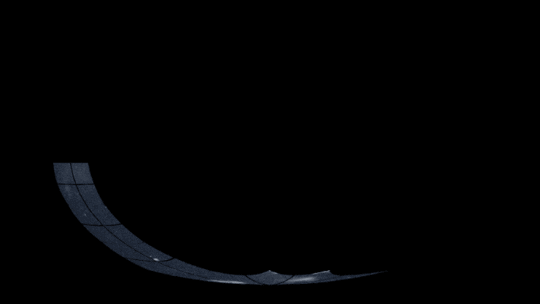
This all-sky mosaic was constructed from 912 Transiting Exoplanet Survey Satellite (TESS) images. Prominent features include the Milky Way, a glowing arc that represents the bright central plane of our galaxy, and the Large and Small Magellanic Clouds – satellite galaxies of our own located, respectively, 160,000 and 200,000 light-years away. In the northern sky, look for the small, oblong shape of the Andromeda galaxy (M 31), the closest big spiral galaxy, located 2.5 million light-years away. The black regions are areas of sky that TESS didn’t image. Credit: NASA/MIT/TESS and Ethan Kruse (University of Maryland College Park)
On April 18, 2018, we launched the Transiting Exoplanet Survey Satellite, better known as TESS. It was designed to search for planets beyond our solar system – exoplanets – and to discover worlds for our James Webb Space Telescope, which launched three years later, to further explore. TESS images sections of sky, one hemisphere at a time. When we put all the images together, we get a great look at Earth’s sky!
In its five years in space, TESS has discovered 326 planets and more than 4,300 planet candidates. Along the way, the spacecraft has observed a plethora of other objects in space, including watching as a black hole devoured a star and seeing six stars dancing in space. Here are some notable results from TESS so far:
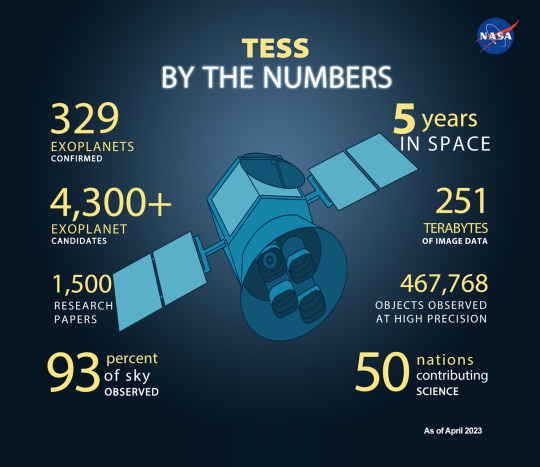
During its first five years in space, our Transiting Exoplanet Survey Satellite has discovered exoplanets and identified worlds that can be further explored by the James Webb Space Telescope. Credit: NASA/JPL-Caltech
1. TESS’ first discovery was a world called Pi Mensae c. It orbits the star Pi Mensae, about 60 light-years away from Earth and visible to the unaided eye in the Southern Hemisphere. This discovery kicked off NASA's new era of planet hunting.
2. Studying planets often helps us learn about stars too! Data from TESS & Spitzer helped scientists detect a planet around the young, flaring star AU Mic, providing a unique way to study how planets form, evolve, and interact with active stars.
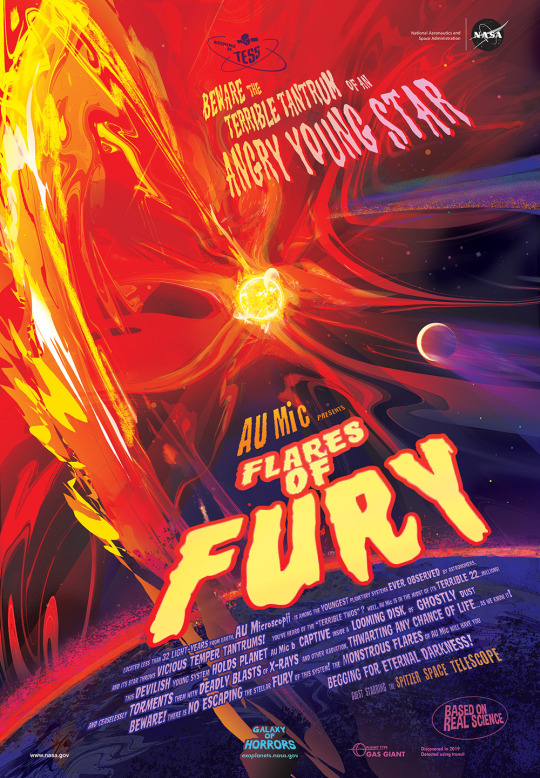

Located less than 32 light-years from Earth, AU Microscopii is among the youngest planetary systems ever observed by astronomers, and its star throws vicious temper tantrums. This devilish young system holds planet AU Mic b captive inside a looming disk of ghostly dust and ceaselessly torments it with deadly blasts of X-rays and other radiation, thwarting any chance of life… as we know it! Beware! There is no escaping the stellar fury of this system. The monstrous flares of AU Mic will have you begging for eternal darkness. Credit: NASA/JPL-Caltech
3. In addition to finding exoplanets on its own, TESS serves as a pathfinder for the James Webb Space Telescope. TESS discovered the rocky world LHS 3844 b, but Webb will tell us more about its composition. Our telescopes, much like our scientists, work together.
4. Though TESS may be a planet-hunter, it also helps us study black holes! In 2019, TESS saw a ‘‘tidal disruption event,’’ otherwise known as a black hole shredding a star.
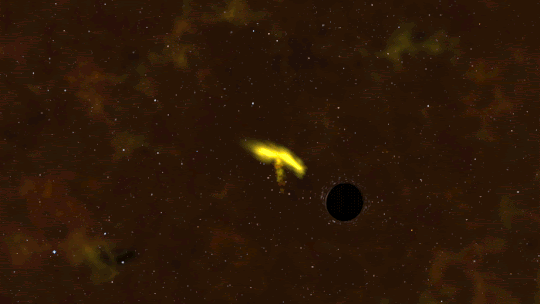
When a star strays too close to a black hole, intense tides break it apart into a stream of gas. The tail of the stream escapes the system, while the rest of it swings back around, surrounding the black hole with a disk of debris. Credit: NASA's Goddard Space Flight Center
5. In 2020, TESS discovered its first Earth-size world in the habitable zone of its star – the distance from a star at which liquid water could exist on a planet’s surface. Earlier this year, a second rocky planet was discovered in the system.
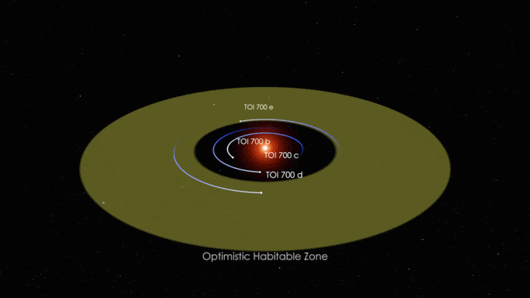
You can see the exoplanets that orbit the star TOI 700 moving within two marked habitable zones, a conservative habitable zone, and an optimistic habitable zone. Planet d orbits within the conservative habitable zone, while planet e moves within an optimistic habitable zone, the range of distances from a star where liquid surface water could be present at some point in a planet’s history. Credit: NASA Goddard Space Flight Center
6. Astronomers used TESS to find a six-star system where all stars undergo eclipses. Three binary pairs orbit each other, and, in turn, the pairs are engaged in an elaborate gravitational dance in a cosmic ballroom 1,900 light-years away in the constellation Eridanus.
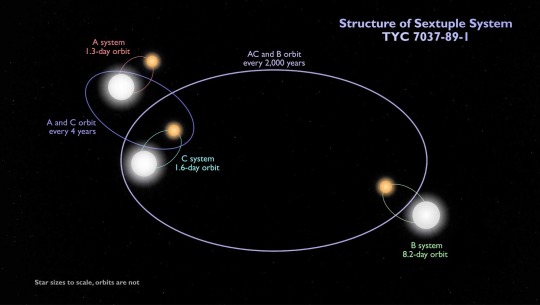
7. Thanks to TESS, we learned that Delta Scuti stars pulse to the beat of their own drummer. Most seem to oscillate randomly, but we now know HD 31901 taps out a beat that merges 55 pulsation patterns.
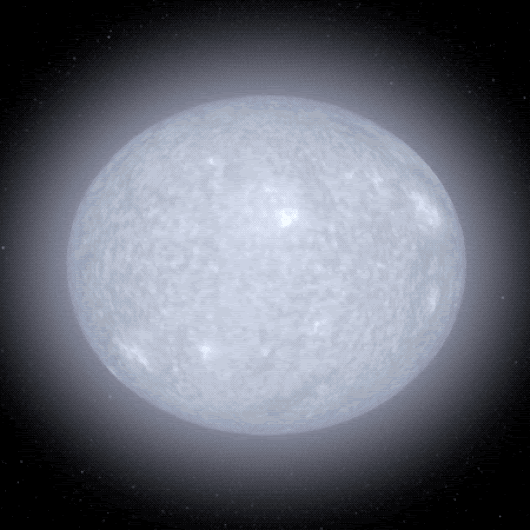
Sound waves bouncing around inside a star cause it to expand and contract, which results in detectable brightness changes. This animation depicts one type of Delta Scuti pulsation — called a radial mode — that is driven by waves (blue arrows) traveling between the star's core and surface. In reality, a star may pulsate in many different modes, creating complicated patterns that enable scientists to learn about its interior. Credit: NASA’s Goddard Space Flight Center
8. Last is a galaxy that flares like clockwork! With TESS and Swift, astronomers identified the most predictably and frequently flaring active galaxy yet. ASASSN-14ko, which is 570 million light-years away, brightens every 114 days!
Make sure to follow us on Tumblr for your regular dose of space!
#space#planets#exoplanets#science#tech#technology#astronomy#astrophysics#stars#black holes#NASA#spaceblr
2K notes
·
View notes
Text
Sornieth Solar System
Sornieth is the fourth planet in its solar system, though it is the only one of its family of seven that is known to be artificial. Understanding Sornieth’s true nature as a constructed planet, and being able to observe our sister worlds without interference from Sornieth’s atmosphere, has allowed us to gain a much more detailed understanding of our solar system.
For a long time, the four inner planets were the only ones known to dragonkind, due to Sornieth’s unique atmospheric distortion and the strange 25-AU gap between Sornieth and the next furthest planet. It was only when we were able to observe from outside the atmosphere that we were able to assemble a truly accurate picture.
(For ease of reading, I will be using Earth as a reference for measurements. 1 AU = distance between Earth and Sun, about 93 million miles or 150 million km.)
SUN
The star of Sornieth’s solar system is a rather ordinary K-type, Population I, main sequence orange dwarf star.
Spectral Type: K2V
Mass: 0.830 solar masses
Radius: 0.785 solar radii
Luminosity: 0.37 solar luminosities
Effective temperature: 5120K
Lifespan: 16 billion years
Age: 10 billion years
Other info / notable details: N/A
Tlinieth
The first planet from the Sun, Tlinieth was once a gas giant. However, its extreme proximity to the star stripped away its atmosphere, leaving behind only its metallic core. The planet is currently extremely dense, though it is in the process of decompressing. From Sornieth, the planet is far too close to the sun to be visible, but its transits cause measurable dips in the Sun’s brightness.
Mass: 30 Earth masses
Radius: 8 Earth radii
Orbital radius: 0.025 AU
Orbital eccentricity: 0.008 (nearly perfectly circular)
Year length: 1.58 days
Day length: 1.58 days (tidally locked)
Composition: Rocky
Atmosphere: None
Moons: None
Other: Astronomers knew of the planet’s existence for thousands of years due to its gravitational influence and slight dips in the Sun’s brightness, but were unable to actually observe it due to its proximity to the star until quite recently. Although recently discovered, its name is derived from the ancient Draconic words meaning “burning planet”.
Kirnieth
Kirnieth, second planet from the Sun, is a small rocky planet with a highly eccentric orbit; it’s theorized the planet may have started out more circular, and had its orbit disrupted by the migration of Tlinieth through the inner solar system. It lacks an atmosphere, and its dark surface is covered in glowing cracks where gravitational stress and asteroid impacts have taken their toll on the crust, exposing the molten mantle.
Mass: 0.10 Earth masses
Radius: 0.44 Earth radii
Semimajor Axis: 0.37 AU
Orbital eccentricity: 0.21 (high eccentricity)
Year length: 90 days
Day length: 16 days
Composition: Rocky
Atmosphere: Very thin, mostly carbon dioxide
Moons: none
Other: Its name is derived from the ancient Draconic words for “dancing planet”, due to its swift motion through the sky and difficulties in predicting its position in ancient times.
Merakai
Merakai has, in the past decade, gone from one of the least interesting planets to the most fascinating. The planet is much more within the star’s habitable zone than Sornieth itself- and is the only other world known to support life. Through the lenses of our best telescopes on Sornieth, the planet’s surface has appeared a smooth, hazy, featureless tan. Upon closer inspection, however, we found the othermost layer of the planet to be riddled with tunnels and rooms too small for any dragons much larger than a skydancer, unmistakably artificial and incredibly ancient- older than Sornieth itself. This planet once supported a vast technologically advanced society. The planet-wide underground complex, which is now known as the Labyrinth, seems to have begun as a crude construction at least 5 million years ago, but was rapidly expanded to cover the whole planet and then even more rapidly abandoned over the total course of 1000-1500 years, 1 million years ago. Why the Labyrinth Builders disappeared is still unknown. Although the planet is no longer home to any megafauna, small ‘plants’, ‘animals’, and microbes continue to thrive.
Mass: 1.21 Earth masses
Radius: 1.10 Earth radii
Orbital radius: 0.5 AU
Orbital eccentricity: 0.018 (near-circular)
Year length: 142 days
Day length: 28 hours
Composition: Rocky
Atmosphere: Nitrogen, oxygen, and other trace gases; slightly thinner than Sornieth. Breathable, but irritates lungs of dragons after prolonged exposure. Beastclans seem to be able to breathe the air indefinitely.
Moons: 13 known small, irregular moons in an impressive ring system
Other: Merakai is the only inner planet whose common name is Beastclan in origin, rather than draconic, though scholars continue to argue about the origins and meaning of the name. It is also the only other currently inhabited planet in the solar system; The Company have been traversing its atmosphere in airships for a few years, and intend to eventually build a permanent base. The Company have also been at the forefront of exploring the Labyrinth and researching those who came before. A few of the researchers believe Merakai was home to the spacefaring common ancestors of many Beastclans long before dragonkind ever existed. A few decades ago, all of us would’ve called this idea madness. Now, we agree it is at least worth a serious investigation.
Sornieth
Sornieth is an extremely recent newcomer to the system, at least on cosmic timescales. The planet is only about 1 million years old, compared to the 10 billion year age of the system. Currently, we believe the planet was constructed from material gathered from the asteroid belt just beyond the planet’s orbit. The planet is hollow, or at least mostly hollow- we don’t know whether the cavity contains air, vacuum, or low-density support structures, but we do know the Rift opening is at the planet’s core, powering all magic on the planet. We are, essentially, living on the outside of a small Dyson sphere.
Mass: 1.87 Earth masses
Radius: 1.6 Earth radii
Orbital radius: 0.94 AU; on the cold outskirts of the star’s habitable zone. The heat that makes liquid water possible at this distance comes from the inside. Our current theory is that, rather than the planet’s distance being a design flaw the Eleven need to divert energy to, Sornieth was created farther away from the Sun intentionally so the gods could use the planet to dissipate excess Rift energy as heat. Perhaps simply building the planet farther away and letting the Rift heat it internally was easier and more efficient than finding a way to limit the flow of energy or cool the core.
Orbital eccentricity: 0.000 (perfectly circular according to our current best measurements)
Year length: 365 days
Day length: 24 hours
Composition: Very dense rocky shell (about 1/10th of total radius); hollow interior. Relatively thin crust over a thin layer of mantle; plate tectonics are extremely slow, with most volcanoes caused by hot spots.
Atmosphere: Nitrogen, oxygen, and other trace gases
Moons: 2 “twin” moons- the Weaver’s Eye and the Binder’s Eye. They are the same size (0.15 Earth radii, 0.01 Earth masses), perfectly spherical, and have seemingly identical color and composition, though the Binder’s Eye is farther away and appears smaller. They are currently unexplored in any detail due to difficulties presented by force field distortion- like trying to make out writing a mile away through a haze of hot air. It’s unknown whether these moons are natural satellites the planet captured, or constructions like Sornieth itself. There have been some indications of structures on the surface, but we haven’t been able to eliminate the possibility that this is simply due to the unique distortion.
Other: Name is ancient Draconic for “our planet”. One of two planets in our solar system known to harbor life. Why the Eleven built it is unknown. Sornieth is the only planet in the system that can sustain magic, due to the Rift. The Rift itself remains mysterious in origin, but what little we know is this: the Rift is a hole between universes, connecting the center of Sornieth to the core of a star in a parallel universe. The Rift leeches energy from the star, which is what makes magic possible here- energy from ‘nothing’, with the Eleven acting as conduits. However, this has destabilized the star and accelerated its demise. The residents of this parallel universe created the Shade as a weapon of self-defense. We are unable to make the details of our research public for security reasons; for more information on the Rift, Shade, or Riftkind, it is necessary to contact the Vigilance personally.
Void Belt
For thousands of years, the solar system was believed to consist only of the four inner planets, with Sornieth marking its outer edge and nothing but asteroids and comets beyond. It’s understandable that scholars believed this to be the case; the idea of there being a nearly 4-billion-kilometer gap between Sornieth and the next planet would’ve been difficult to take seriously, especially without much visible evidence. The outer planets orbit slowly, and with atmospheric distortion, most of them are invisible to the naked eye and nearly impossible to spot even with a telescope. It wasn’t until we were able to observe our solar system from space that these planets were discovered. The 25-AU gap- which we call the Void Belt- contains several asteroid belts and swarms of comets, but nothing large enough to qualify as a dwarf planet.
Shanieth
Shanieth is a frozen water world, the closest of the recently discovered Outer Planets. Although we have sent a probe to explore it, it will be decades before that probe arrives. Unless we can build something faster, or spare a large amount of resources to send Horizon Seeker, it will be a long time before Shanieth reveals her mysteries.
Mass: 2.3 Earth masses
Radius: 1.3 Earth radii
Orbital radius: 26 AU
Orbital eccentricity: 0.07
Year length: 217.9 years
Day length: 19.4 hours
Composition: Rocky, with thick outer layer of ice/water.
Atmosphere: Thick; nitrogen, oxygen, water vapor and carbon dioxide. Greenhouse effect makes the planet somewhat warmer, but not enough to make it habitable for any known macroscopic life.
Moons: None; three very thin rings.
Other: Name is ancient Draconic for “frozen planet”, to accompany Tlinieth. It’s likely the planet’s water layer is not frozen all the way through, but has a several-kilometer-deep ice ‘shell’ with an extremely deep liquid ocean beneath heated by pressure and the planet’s interior. It’s theorized this ocean may sustain some extremely strange alien life, but so far we don’t have conclusive evidence either way.
Xai
Xai is a brilliant blue gas giant with a large, beautiful icy ring system, and is the second largest planet.
Mass: 69 Earth masses
Radius: 4.2 Earth radii
Orbital radius: 30 AU
Orbital eccentricity: 0.05
Year length: 270.1 years
Day length: 11 hours
Composition: Gas giant; primarily hydrogen, helium
Moons: 28 known
Other: The name is derived from an ancient Maren sky deity.
Osoba
Osoba is a small brown dwarf, an object between the largest gas giants and the smallest stars; large enough to fuse deuterium, but not massive enough to fuse hydrogen to helium in their cores like proper stars. It glows a dim magenta, and has a surface temperature of about 600K. It is not visible with the naked eye from Sornieth and is barely visible as an extremely faint magenta object through telescopes. Osoba is younger than the rest of the solar system, which coupled with its highly eccentric orbit suggests this may in fact be a failed star captured by the Sun, rather than something that formed in the solar system. We’ve been unable to explore it in much detail; we plan to send the Horizon Seeker there as a test run of its deep space travel capabilities before we attempt a mission to another star system.
Mass: 9550 Earth masses
Radius: 11.5 Earth radii
Semimajor axis: 60 AU
Orbital eccentricity: 0.25
Year length: 764 years
Day length: uncertain
Composition: Mostly hydrogen, helium
Moons: 34 known, 4 of them large enough that they could be considered dwarf or small planets if they weren’t moons.
Other: Name derived from the ruler of the Serthis underworld.
181 notes
·
View notes
Note
Wait, so could an Ice Giant actually being be darker blue shades or simply just hazy greenish blue? I'm just asking sense I'm in the middle of making my own star system. (Also could a rocky planet have a green to greenish atmosphere? I saw a few on space engine and wonder if such is possible realistically. Would it have to be like a steam world?)
I think there is some room for variation--remember, even in the reprocessed image, Uranus & Neptune aren't identical colors--but generally you should expect ice giants to be pale/dull blue. The clouds are not themselves blue; they are white, brownish, or grayish ammonium and ammonium hydrosulfide clouds like on Jupiter & Saturn. (and in the case of Uranus, a white photochemical haze.) Uranus & Neptune just have a lot of methane in their atmospheres, which absorbs red light.
There are various types of hot jupiters and hot neptunes that may be a very deep blue or a sky-blue. For example warm gas giant planets that get about as much starlight as Mercury will have a deep sky-blue color as they may completely lack clouds. Similarly I think there's some cloud compositions for hot jupiters that result in deep azure colorations iirc.
And anything with an exposed liquid water ocean, like Earth, can be deep blue. A Hycean (HYdrogen & oCEAN) planet for example--a super-earth-mass world with a hydrogen-rich atmosphere and a liquid water ocean, could potentially look deep blue from space, depending upon what the clouds are doing.
I think steam worlds might could be deep blue if they have liquid water if the steam never condenses into a thick water droplet cloud layer. The atmosphere would be sky-blue due to rayleigh scattering and the surface would be deep blue because water is dark blue. If it does have a lot of clouds, then it'd just be white like Venus. I'm not sure if that would arise or not.
5 notes
·
View notes
Link
As astronomers have begun to gather data on the atmospheres of planets, we’re learning about their compositions and evolution. Thick atmospheres are the easiest to study, but these same thick atmospheres can hide the surface of a planet from view. A Venus-like world, for example, has such a thick atmosphere making it impossible to see the planet’s terrain. It seems the more likely we are to understand a planet’s atmosphere, the less likely we are to understand its surface. But that could change thanks to a new study in the Monthly Notices of the Royal Astrophysical Society. Rocky worlds have a rich chemical exchange between their surfaces and their atmospheres. On Earth, the cycles of rain and evaporation, seasons of growth and harvest, and volcanic activities change the atmospheric composition over time. These exchanges happen over a long timescale, so Earth’s surface and atmosphere are never in a state of mutual equilibrium. On Venus, with its thicker atmosphere and dry surface, the timescale of exchange is shorter, but still not fast enough to reach a balance. In this study, the authors argue that for warm Venus-like worlds with particularly thick atmospheres, a chemical equilibrium between surface and air can be reached. These worlds are the kind we find closely orbiting small stars, so they are well-suited for atmospheric studies. How different types of terrestrial worlds affect their atmospheres. Credit: Byrne, et al To show how this works, the team simulated chemical interactions right at the interface between the atmosphere and the rocky surface. Their simulations showed that chemical equilibrium for simple molecules such as carbon dioxide the atmosphere of Venus can be used to probe the composition of its surface, and depending on surface temperature, Venus-like exoplanets could see strong interactions for more complex molecules CaAl2Si2O8 and MgAl2O4. In other words, under the right circumstances, small rocky worlds closely orbiting their warm star are excellent candidates for this kind of study. What we learn about their atmospheres can open a window on the composition of their surface, and even their geological activity. We could even determine whether certain minerals are present or absent on the surface of an exoplanet, without ever viewing its surface directly. This kind of information is vital to our understanding of how terrestrial planets form. Previous studies have already shown that our solar system is rather unusual and that a solar system free of large planets in the inner solar system is rare. By understanding the evolution and composition of the inner planets of other stars, we will learn why our solar system is unusual, and perhaps even learn if life such as ours is common or rare in the Universe. Reference: Byrne, Xander, et al. “Atmospheres as a Window to Rocky Exoplanet Surfaces.” Monthly Notices of the Royal Astronomical Society (2023): stad3914. The post The Atmosphere of an Exoplanet Reveals Secrets About Its Surface appeared first on Universe Today.
3 notes
·
View notes